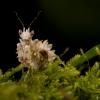- Formiculture.com
- Forums
- Gallery
- Members
- Member Map
- Chat

Formica integra in the southeast?
Started By
Runner12
, Oct 15 2017 3:46 PM
4 replies to this topic
#1
 Offline
-
Posted October 15 2017 - 3:46 PM
Offline
-
Posted October 15 2017 - 3:46 PM
Has anyone here in the southeast, specifically SC, NC, GA area ever seen Formica integra? I've been looking for this species for months and I've only ever found one single nest, and it was at a rest stop,no way I could collect anything from it.
From the research I've read they're supposed to be abundant along the SC NC border in the western parts of the state, but I've yet to find them, despite the fact that they're supposed to have huge polygynous colonies. Been searching multiple forested areas and nothing.
From the research I've read they're supposed to be abundant along the SC NC border in the western parts of the state, but I've yet to find them, despite the fact that they're supposed to have huge polygynous colonies. Been searching multiple forested areas and nothing.
#2
 Offline
-
Posted October 15 2017 - 7:21 PM
Offline
-
Posted October 15 2017 - 7:21 PM
Just asking but not to be rude, but why would you like to keep them? They are very difficult to start off from a queen and you need a constant supply of formica brood. However, try looking in or directly(and I mean directly) next to forests during the months of July and the Beginning and Middle of August. Queens can be found during end of July. Note when collecting pupae- be careful since most pupae of other formica species dhring these months will be alate brood. Choose smaller pupae, bht even those might be male pupae, or try getting callow workers. Good luck!
Also Pine forests seem to yield better colonies.
Also Pine forests seem to yield better colonies.
Proverbs 6:6-8 New International Version (NIV)
6 Go to the ant, you sluggard;
consider its ways and be wise!
7 It has no commander,
no overseer or ruler,
8 yet it stores its provisions in summer
and gathers its food at harvest.
#3
 Offline
-
Posted October 15 2017 - 7:28 PM
Offline
-
Posted October 15 2017 - 7:28 PM
They're not a parasitic species as far as I know, at least not once the colony is established.
I would probably just collect a few queens and some workers since there are usually dozens of queens per colony.
I've read the same thing about them being common at the edge of forests, but still haven't had much luck unfortunately.
I would probably just collect a few queens and some workers since there are usually dozens of queens per colony.
I've read the same thing about them being common at the edge of forests, but still haven't had much luck unfortunately.
Edited by Runner12, October 15 2017 - 7:31 PM.
#4
 Offline
-
Posted October 15 2017 - 7:47 PM
Offline
-
Posted October 15 2017 - 7:47 PM
Formica integra is a temporary social parasite from the rufa group, not a raiding species from sanguinea.
Raiding-type Formica have the similarly named Formica subintegra, which are very dependent on their host species.
Edited by Batspiderfish, October 15 2017 - 7:49 PM.
If you've enjoyed using my expertise and identifications, please do not create undue ecological risk by releasing your ants. The environment which we keep our pet insects is alien and oftentimes unsanitary, so ensure that wild populations stay safe by giving your ants the best care you can manage for the rest of their lives, as we must do with any other pet.
Exotic ants are for those who think that vibrant diversity is something you need to pay money to see. It is illegal to transport live ants across state lines.
----
Black lives still matter.
#5
 Offline
-
Posted October 15 2017 - 7:51 PM
Offline
-
Posted October 15 2017 - 7:51 PM
Ok nice to know that for sure, I couldn't really find a straight answer in anything I read as to how they found colonies.
Budding was the best answer I found.
Budding was the best answer I found.
- TennesseeAnts likes this
1 user(s) are reading this topic
0 members, 1 guests, 0 anonymous users















